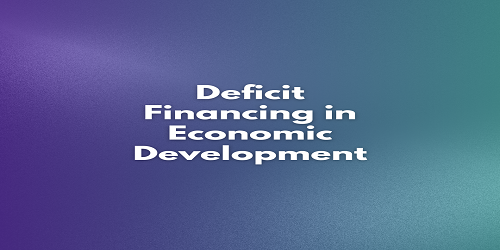Table of Contents
Deficit Financing in Economic Development:
Deficit Financing has its origin in the wartime financial needs of the government when it was found difficult to mobilize adequate resources for meeting the needs of war expenditure through normal methods of raising resources. It was also advocated as an instrument of economic policy by Keynes in the context of the depression to raise the level of output and employment.
The use of inflationary finance for raising the rate of economic development is essentially a post-war development. This has synchronized with the revival of theoretical interest in long-term problems of economic growth and practical attempts by underdeveloped countries to raise their levels of living through planned development policy.
Since government undertakes the task of promoting and accelerating economic development, fiscal policy assumes crucial importance in less developed areas. After making strenuous efforts to raise as many resources as possible through taxation, borrowing, and external finance, there may still remain a gap between the available receipts and the investment expenditure necessary for rapid economic development. The government of an underdeveloped country may, therefore, have to adopt the device of deficit financing as a last resort.
Though originally intended for achieving full employment and as an economic stabilizer in advanced economies, deficit financing can be helpful in backward economies to attaing the objective of economic development. Like other spheres, fiscal policy is also in an underdeveloped stage in most of these economies. By adding the element of modernity to its fiscal programmes and by unfolding a bold and adventurous program of managed deficit financing, these countries can find a reasonable solution for accelerating their economic plans. Thus, deficit financing has been considered a useful method for financing the development plans of underdeveloped countries.
Thus, deficit financing is an important method for financing the development plans of underdeveloped countries and accelerating their rate of economic development. But, it should not have resorted to such an extent that the rise in the prices as a result of deficit financing may become intolerable to the economy and, instead of achieving the objective of an accelerated rate of growth it may lose the very rate of growth. However, a rise of 2 to 3 percent in general price level may not adversely affect the growth rate but may prove conducive to it. But a sharp and continuous increase in prices may adversely affect the growth rate of underdeveloped economies. Hence, it is concluded that the technique of deficit financing for financing development plans is not only useful, but essential for underdeveloped economies, and the principle of growth with stability should be preferred to the principle of unbalanced growth.
The role of deficit financing as an instrument of economic development may be assessed from three points of view:
- As a method that makes available the surplus resources which exist in the economy and which cannot be mobilized due to scarcity of financial resources.
- As a method to generate new resources in the form of forced savings.
- As a method that has the capacity to increase the supply of resources as the economy develops.
Mobilization of Surplus Resources and Un-utilized Resources:
Capital formation is one of the basic conditions for the economic development of underdeveloped countries. It is one of the biggest problems which underdeveloped countries used to face when they decide to undertake their development plans. The role of deficit financing for the mobilization of surplus and unutilized resources which exist in the economy has been discussed below:
Deficit financing may prove helpful in making the best use of unutilized and surplus resources which exist in the economy. Thus, deficit financing can be used as an instrument for increasing production and employment. It is in this context that Keynes advocated deficit financing for the mobilization of surplus labor and other unemployed resources of the economy during the period of depression, for increasing the level of income and employment. Thus, deficit financing is of vital importance for the mobilization of such resources. But, it is true for developed countries only.
The agricultural sector is the largest sector of underdeveloped countries, but there generally does not exist any idle plants and equipment. Similarly, in the industrial sector, there normally does not exist any idle productive capacity. But there exists a large volume of surplus unemployed labor in the rural sector of an underdeveloped country. If this unemployed labor is employed through deficit financing, it may generate inflationary pressure in the economy as there is no. Idle productive capacity in agricultural as well as non-agricultural sectors. Hence, deficit financing may not prove very useful for the mobilization of unemployed resources of underdeveloped economies without creating productive capacity in agricultural and industrial sectors. However, it doesn’t mean that underdeveloped countries should outrightly reject deficit financing for the utilization of their surplus manpower resources. Moreover, a mild dose of inflation may provide incentives for the utilization of such resources.
Deficit Financing and Creation of New Resources:
Deficit financing by the government, which results in inflation, may have the aim of transferring resources from private use to government use in the form of forced savings. These resources are transferred from private use to government as a result of the reduction in consumption used for deficit financing i.e., increased prices. Such transfer of resources is called forced savings.
in underdeveloped countries, voluntary savings are not enough to finance their development plans. Therefore, deficit financing has resorted which results into increase prices. But increased prices reduce consumption. Hence, savings become forced. Thus, deficit financing has been strongly recommended for the mobilization of savings, i.e., for the creation of new resources, which can be utilized for financing further development plans. In this context, professor Kurihara said that underdeveloped economies should be encouraged to develop their productive resources rapidly as possible without any fear of inflation. Prof. W. A. Lewis also said that “Inflation for the purpose of capital formation is in due course self-destructive.” Thus Prof. Lewis seems to favor the adoption of deficit financing, if inflation proves to be self-destructive and, if it is punctuated every three or four years by a little deflation of prices.
Deficit Financing When the Economy is Developing:
As already stated underdeveloped economies generally suffer from the scarcity of financial resources because of their low per capita income and high propensity to consume. When an underdeveloped country is developing, i.e., output and employment, are increasing as a result of its planned economic development, but without any inflationary pressure upon the economy, as was the situation of the Indian economy after the First Five Year Plan, i.e., the economy was growing without any inflation or with a very mild degree of inflation. In such conditions, the role of deficit financing has been considered of utmost importance, to accelerate the rate of economic development, since the process of development would. tend to be hampered by persistent deflationary pressure.
In this context, it has been rightly pointed out that “It must not be assumed that, because the creation of bank credit to finance development plan may lead to inclination, there is no positive or constructive role for appropriate credit policy. On the contrary, because there is a deficiency of real resources, credit policy must be alert to ensure that a deficiency of money, as distinguished from a deficiency of real resources does not further impede development. And it must be allowed to ensure that whatever credit is made available through the banking system has the greatest possible effect in increasing production.” It has been further emphasized that “The expansion of money supply within proper limits in a growing economy represents an increment of real resources for investment so long as the expansion of money supply is no more than enough to finance the larger volume of production, consumption, and investment at stable prices, it is not only non-inflationary but it is essential to the proper functioning of the economy.” Thus, deficit financing can play a very important role in accelerating the pace of development of developing economies, if it is kept within proper limits. Moreover, deficit financing should not be self-cumulative but, it must be self-destructive.









Comments (No)